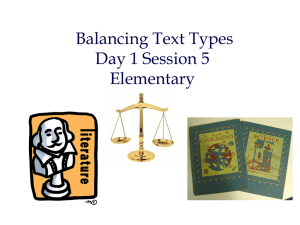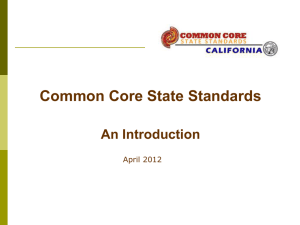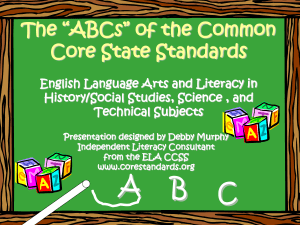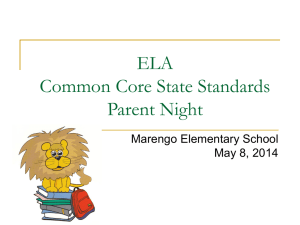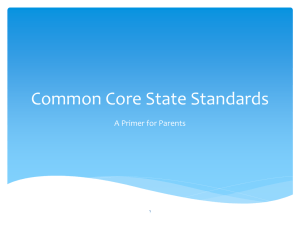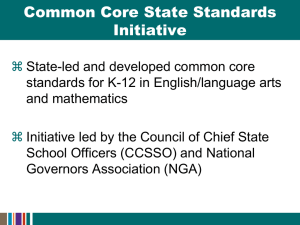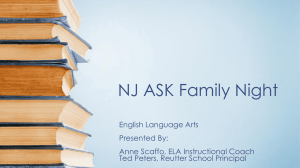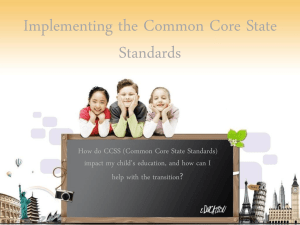complex text
advertisement
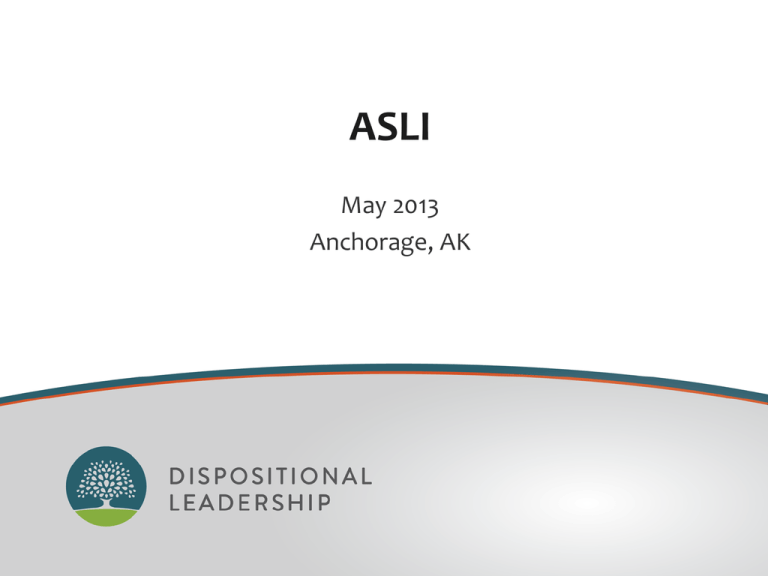
ASLI May 2013 Anchorage, AK Welcome Goals for today • Deepen cognitive depth with Alaska State ELA Standards. • Build understanding of concepts with formative and summative assessment with the new standards Chalk Talk Protocol • Draw a circle in the middle of your paper • Record everything you know about the ELA standards inside the circle Commitment to Continuous Growth and Thinking with Precision Increases cognitive understanding through self-directed professional development. New Alaska Standards • Structural – How are standards organized – What is the same and different from prior standards • Instructional – What level of rigor will be required – How to increase student performance with new standards – What instructional techniques/approaches will I need to deploy Foundational Skills Jigsaw Common Core Document • Number off into 1-4 • Each member read section of document • Record 3 most relevant pieces of information • Share with group in order Foundational Skills •Print Concepts (K – 1) • Phonological Awareness (K – 1) • Phonics and Word Recognition • Fluency (K – 5) (K – 5) Implications for Leaders LENS #3, pg 70 History, Science and Technical Subjects The CCSS Requires Three Shifts in ELA/Literacy 1. Building knowledge through content-rich nonfiction 2. Reading, writing, and speaking grounded in evidence from text, both literary and informational 3. Regular practice with complex text and its academic language 11 Shift #1: Building Knowledge Through Content-Rich Nonfiction AK ELA Standards: Reading (6-12) Anchor Standard Grade Specific Standard Examples (Informational Text) Craft and Structure 5. Analyze the structure of texts, including how specific sentences, paragraphs, and larger portions of the text (e.g., a section, chapter, scene, or stanza) relate to each other and the whole. Grade 7 5. Analyze the structure an author uses to organize a text, including how the major sections contribute to the whole and to the development of the ideas. Grade 8 5. Analyze in detail the structure of a specific paragraph in a text, including the role of a particular sentence in developing and refining a key concept. Grades 11-12 5. Analyze and evaluate the effectiveness of the structure an author uses in his or her exposition or argument, including whether the structure makes points clear, convincing, and engaging. 13 AK ELA Standards: Writing (6-12) Anchor Standard Grade Specific Standard Examples Text Type and Purposes 2. Write informative/explanatory texts to examine and convey complex ideas and information clearly and accurately through the effective selection, organization, and analysis of content. Grade 6 2(a). Introduce a topic; organize ideas, concepts, and information, using strategies such as definition, classification, comparison/contrast, and cause/effect; including formatting (e.g., headings), graphics (e.g., charts, tables), and multimedia when useful in aiding comprehension. Production and Distribution of Writing 4. Produce clear and coherent writing in which the development, organization and style are appropriate to task, purpose, and audience. Note: This standard is repeated at each grade level noting that specific expectations for writing types14are defined in standards 1-3 for each grade level. Text structure refers to the ways that authors organize information in text. Handout 16 Text Structures Narrative Character(s) Setting Informational Cause/Effect Compare/Contrast Problem/Conflict Description Events Chronology/Sequence Resolution/Outcomes Theme 17 Problem/Solution Your Turn: Identifying Text Structure Using the information about each of the five text structures from your handout, identify the text structure of each of the passages about the Olympics in your handout. Circle any signal words. Think about intended purpose. Underline important information. 18 Comprehension Text Structure • Listen for the following items: – Signal words – Low level text – Graphic organizers – Read aloud – Cooperative Learning (Rally Table) Explicit Text Structure Instruction 1. Teacher selects appropriate texts and examples. 2. Teacher explains the task and its importance. 3. Teacher models the task. 4. Teacher and students practice the task. 5. Independent practice/application. 6. Revisit, remind, review, recheck—and repeat! 20 Dinoflagellates play an important role in marine ecosystems. Together with diatoms and coccolithophores, they are a major component of phytoplankton that provide food directly or indirectly many marine animals. Their flagella, mixtrophic nutrition, ability to migrate vertically in the water column and lack of independence on silicon give dinoflagellates an ecological advantage over diatoms. On the other hand, aside from predation, to which the diatoms are subjected as well, dinoflagellates are less tolerant of stormy seas. Their relatively large size and multiplated structure increase their chance of cells being torn apart. (Introduction to Marine Biology, Karleskint Turner Small, pg 145 CAUSE Why did it happen? EFFECT What happened? The economy of nearly every city was impacted by the flu epidemic of 1918. The workforce was paralyzed because 21-to-29 year olds suffered the greatest casualties. Essential services were on the verge of collapse since workers like firemen, nurses, and garbage collectors were too sick to come to work. New public health ordinances prohibiting public gatherings resulted in theaters, cinemas and hotels losing millions of dollars. As a result of the unexpected high volume of deaths among the young, insurance actuarial projections were incorrect. Therefore, many insurance companies were unable to pay life insurance claims. Adapted from ELA CCSS document, Appendix c, pp. 80–81. 22 CAUSE Why did it happen? EFFECT What happened? The economy of nearly every city was impacted by the flu epidemic of 1918. The workforce was paralyzed because 21-to-29 year olds suffered the greatest casualties. Essential services were on the verge of collapse since workers like firemen, nurses, and garbage collectors were too sick to come to work. New public health ordinances prohibiting public gatherings resulted in theaters, cinemas and hotels losing millions of dollars. As a result of the unexpected high volume of deaths among the young, insurance actuarial projections were incorrect. Therefore, many insurance companies were unable to pay life insurance claims. Adapted from ELA CCSS document, Appendix c, pp. 80–81. 23 CAUSE Why did it happen? EFFECT What happened? The economy of nearly every city was impacted by the flu epidemic of 1918. The workforce was paralyzed because 21-to-29 year olds suffered the greatest casualties. Essential services were on the verge of collapse since workers like firemen, nurses, and garbage collectors were too sick to come to work. New public health ordinances prohibiting public gatherings resulted in theaters, cinemas and hotels losing millions of dollars. As a result of the unexpected high volume of deaths among the young, insurance actuarial projections were incorrect. Therefore, many insurance companies were unable to pay life insurance claims. Adapted from ELA CCSS document, Appendix c, pp. 80–81. 24 CAUSE Why did it happen? EFFECT What happened? The economy of nearly every city was impacted by the flu epidemic of 1918. The workforce was paralyzed because 21-to-29 year olds suffered the greatest casualties. Essential services were on the verge of collapse since workers like firemen, nurses, and garbage collectors were too sick to come to work. New public health ordinances prohibiting public gatherings resulted in theaters, cinemas and hotels losing millions of dollars. As a result of the unexpected high volume of deaths among the young, insurance actuarial projections were incorrect. Therefore, many insurance companies were unable to pay life insurance claims. Adapted from ELA CCSS document, Appendix c, pp. 80–81. 25 CAUSE Why did it happen? EFFECT What happened? The economy of nearly every city was impacted by the flu epidemic of 1918. The workforce was paralyzed because 21-to-29 year olds suffered the greatest casualties. Essential services were on the verge of collapse since workers like firemen, nurses, and garbage collectors were too sick to come to work. New public health ordinances prohibiting public gatherings resulted in theaters, cinemas and hotels losing millions of dollars. As a result of the unexpected high volume of deaths among the young, insurance actuarial projections were incorrect. Therefore, many insurance companies were unable to pay life insurance claims. Adapted from ELA CCSS document, Appendix c, pp. 80–81. 26 Morning Concept Attainment • Review your Chalk Talk chart • Add to your Chalk Talk outside of your circle Lunch Shift #2: Reading, Writing, and Speaking Grounded in Evidence From Text, Both Literary and Informational Not Text Dependent In “Casey at the Bat,” Casey strikes out. Describe a time when you failed at something. In “Letter From Birmingham Jail,” Dr. King discusses nonviolent protest. Discuss, in writing, a time when you wanted to fight against something that you felt was unfair. In “The Gettysburg Address” Abraham Lincoln says the nation is dedicated to the proposition that all men are created equal. Why is equality an important value to promote? 30 Text Dependent What makes Casey’s experiences at bat humorous? What can you infer from King’s letter about the letter that he received? “The Gettysburg Address” mentions the year 1776. According to Lincoln’s speech, why is this year significant to the events described in the speech? WHAT TEXT-DEPENDENT QUESTIONS ARE: • Questions that can only be answered with evidence from the text • Can be literal but can also involve analysis, synthesis, evaluation • Focus on word, sentence and paragraph as well as larger ideas, themes or events • Focus on difficult portions of text in order to enhance reading proficiency WHY TEXT-DEPENDENT QUESTIONS? or, WHY NOT GO OUTSIDE THE TEXT? • More time inside the text less outside • Going outside the text privileges those who have that experience • It is easier to talk about our experiences than to analyze the text • These are college and career standards Close Reading • Reading with pen (or pencil) in hand – taking notes as you go through the text • Reading, and rereading, and rereading again to uncover layers of meaning • Asking and answering questions about the text – especially how and why Close Reading of Complex Text • Great books (challenging books) need to be read and reread • Each reading should accomplish a separate purpose – 1st purpose: Allows the reader to determine what a text says – 2nd purpose: Allows a reader to determine how a text works – 3rd purpose: Allows the reader to evaluate the quality and value of the text (and to connect the text to other texts) —Timothy Shanahan A Guide to Creating Text-Dependent Questions for Close Analytic Reading Discuss how the process for generating questions may be different than past classroom practices. WHY TEXT-DEPENDENT QUESTIONS? or, WHY NOT GO OUTSIDE THE TEXT? • More time outside the text less inside • Going outside the text privileges those who have that experience • It is easier to talk about our experiences than to analyze the text • These are college and career standards BASAL ALIGNMENT PROJECT Council of the Great City Schools and Student Achievement Partners Cleveland, Ohio September 13-14, 2012 WHAT THEY DID NOT DO • Will not alter sections on phonics, spelling, grammar, word study, science and social studies connections • Will not be supporting any supplemental texts such as leveled readers. • However aligned questions and culminating tasks will take longer Shift #3: Regular Practice With Complex Text and Its Academic Language 39 Features of Complex Text • • • • • • • • Subtle and/or frequent transitions • • Longer paragraphs Multiple and/or subtle themes and purposes Density of information Unfamiliar settings, topics, or events Lack of repetition, overlap, or similarity in words and sentences Complex sentences Uncommon vocabulary Lack of words, sentences, or paragraphs that review or pull things together for the student Any text structure that is less narrative and/or mixes structures •Levels of meaning •Levels of purpose •Structure •Organization •Language conventionality •Language clarity •Prior knowledge demands •Word length •Word frequency •Word difficulty •Sentence length •Text length •Text cohesion •Motivation •Knowledge and experience •Purpose for reading •Complexity of task assigned and questions asked regarding text 41 Scaffolding Complex Text The standards require that students read appropriately complex text at each grade level, independently (Standard 10). However, there are many ways to scaffold student learning, including: • • • Allowing for multiple readings of the same text Read Aloud Chunking a text (taking a little at a time) Provide support while reading, rather than before. What have we covered? • Awareness Phase – Standards Awareness • Transition Phase – Foundational Skills – Informational Text – Text Structure with informational text – Multiple Rereads – Basal Alignment Project – Complex text Testlets District & Principal Responsibility What have we covered? • Awareness Phase – Standards Awareness • Transition Phase – Foundational Skills – Informational Text – Text Structure with informational text – Multiple Rereads – Basal Alignment Project Adaptive Challenges Transition… Moving from my knowledge to supporting staff in the transition Team Time #2 Assessing the Phases… Awareness Transition Implementation Knowing our target Closing

